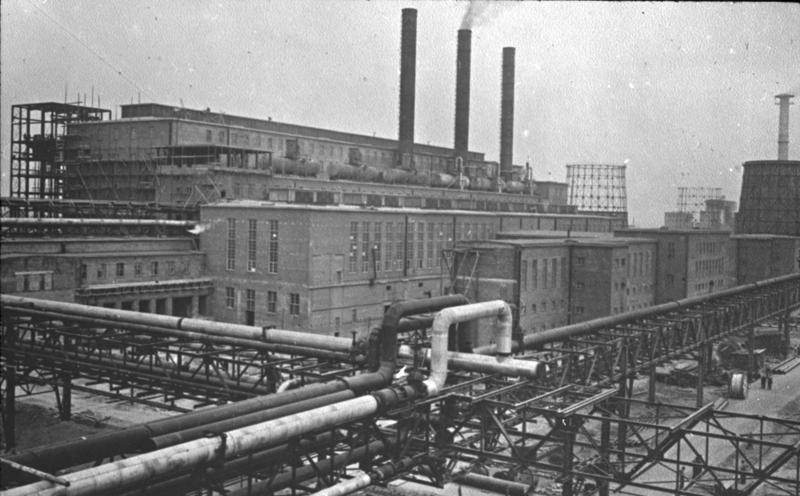This article explains how forced labour shaped the Auschwitz complex, with a focus on Auschwitz III-Monowitz (Buna) and the nearby IG Farben works. For the overall site layout, see The Structure of the Auschwitz Complex, and for the origins of the camp system, see The Origins of Auschwitz.
On this page: Why Monowitz was created · Companies, contracts and profits · Working and living conditions · Mortality and prisoner categories · Accountability after the war · Monowitz in the wider Auschwitz complex
Authoritative overviews: Auschwitz-Birkenau State Museum – The camp complex · United States Holocaust Memorial Museum – Auschwitz
Why Monowitz was created
In 1942 the SS established Auschwitz III-Monowitz to supply enslaved labour to nearby industry, above all the IG Farben synthetic rubber and fuels plant. The location reduced transport time, placed prisoners next to key works and allowed the SS to respond quickly to industrial labour demands.
Monowitz grew alongside a network of subcamps. Its function illustrates how exploitation and mass murder were structurally linked within the Auschwitz system. For the map and roles of Auschwitz I and II-Birkenau, see The Structure of the Auschwitz Complex.
Companies, contracts and profits
The SS leased prisoners to firms for daily fees. IG Farben was the largest beneficiary, but other companies also used prisoner labour. Contracts specified numbers, categories and expected outputs; the SS retained control over discipline, accommodation and rations, while companies benefited from a workforce that could be expanded or replaced at short notice.
Economic goals drove production targets, yet work regimes were set in ways that ignored human survival. The model externalised costs to the camp administration and internalised profits for participating firms. An overview of the system appears in the USHMM entry on Auschwitz.

Working and living conditions
Conditions in Monowitz were brutal: starvation-level rations, inadequate clothing, exposure to chemicals and long shifts with minimal medical care. Prisoners faced beatings and selections when illness or exhaustion reduced output. Barracks were overcrowded and sanitation was poor, contributing to disease.
Survival depended on many factors – assignment, health, mutual aid, and chance. For the background to numbers, testimonies and how historians estimate mortality, see Victims and Survivors of Auschwitz.
Mortality and prisoner categories
Monowitz held prisoners of various categories, including Jews deported from across occupied Europe, as well as non-Jewish prisoners transferred from other parts of the complex. Mortality was extremely high due to work conditions, malnutrition, disease and violence. Selections removed those deemed “unfit”, who were often sent back to Birkenau and murdered.
Figures for Monowitz must be treated carefully. Post-war investigations and subsequent research provide ranges rather than exhaustive totals. Where precise numbers are impossible, we use well-established estimates and explain sources in the linked articles.
Accountability after the war
After 1945, aspects of forced labour and corporate involvement appeared in post-war trials and investigations. Proceedings examined the responsibility of SS personnel and, in some cases, executives associated with wartime plants. The legal record is uneven, but it documents how industrial aims were pursued through the camp system.
This section provides context rather than a full legal history. Readers interested in individuals and administrative structures should see upcoming profiles linked from The Origins of Auschwitz and The Structure of the Auschwitz Complex.
Monowitz in the wider Auschwitz complex
Monowitz functioned within a system: Auschwitz I concentrated command and administration; Auschwitz II-Birkenau handled deportations, selections and killing; Monowitz and selected subcamps supplied labour to SS-run enterprises and private industry. Transports, records and personnel moved between these parts, linking exploitation and murder.
Acts of resistance occurred wherever prisoners lived and worked, including in labour details and workshops. For a broader view, see Resistance and Escapes from Auschwitz. For the events of January 1945 and the memory of 27 January, see Liberation of Auschwitz and the Memory of 27 January.
Methodology note: statistics in this article draw on post-war investigations and decades of historical research. Where precise totals are impossible, we cite ranges used by leading institutions and explain context in linked articles.
Read next
Victims and Survivors of Auschwitz: Numbers, Sources, Testimonies
The Structure of the Auschwitz Complex: Auschwitz I, Birkenau, Monowitz
Resistance and Escapes from Auschwitz
The Origins of Auschwitz: From Polish Barracks to Nazi Concentration Camp
